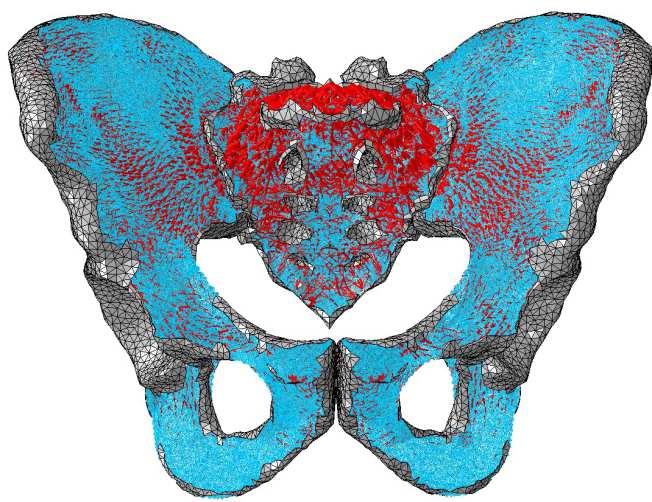Pelvis

The project is focused on developing a biofidelic computational model of the pelvic region, including both hard and soft tissue. A skeletal model of the pelvis is obtained through structural optimisation, based on the same iterative adaptation method already in use for the lower limb structural model. A finite element representation of the soft tissue within the pelvis region is to be added to the skeletal model. This complete model is hoped to give a better understanding of how soft tissue injury is initiated in a blast impact scenario.
Hard tissue modelling
Using the method applied for the mesoscale structural model of the femur, the model of the skeletal pelvis is built based on CT scans, from which a volume mesh consisting of tetrahedral elements is obtained. The surface nodes of the mesh are used to create shell elements, whilst truss elements are generated by pairing nodes within the volume. The shell elements will represent cortical bone, with trabecular bone being characterised by the truss elements.
Experimentally obtained loading conditions using the London Lower Limb musculoskeletal model are applied to the FE model, and after analysing the strains occurring in the pelvis model, the thicknesses and radii of the shells and trusses adapt in order to achieve a target strain. Thus, the structure of the model in the converged state is similar to that of a human pelvis.
Soft tissue modelling
Ligaments and muscles are added to the pelvis model in order to have more realistic boundary conditions. The main blood vessels and organs within the pelvic region will be represented in the model with the purpose of investigating whether bone fracture causes damage of the soft tissue components specified.
Publications
Further details of the work are given in:
- Zaharie DT, Phillips ATM, A comparative study of continuum and structural modelling approaches to simulate bone adaptation in the pelvic construct, Applied Sciences, 2019
- Zaharie DT, Phillips ATM, Pelvic Construct Prediction of Trabecular and Cortical Bone Structural Architecture, Journal of Biomechanical Engineering, 2018


